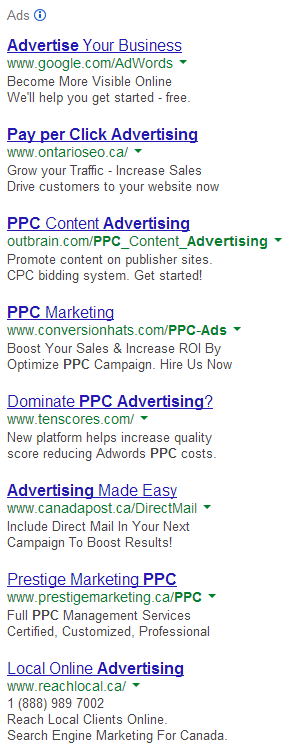Pay-per-click advertising, or PPC, is one of the most effective ways of attracting new business online. Even more importantly, this form of online advertising makes it easy to track conversions to compare against your goals and calculate your ROI. The best and biggest example of a PPC advertising platform is Google AdWords. Just like all marketing, there is no exact science to PPC advertising and it comes with many challenges; here are some important factors to take into account when creating an effective PPC advertisement.
Before You Start Writing:
- Set your goals.
Why are you running this campaign? Are you trying to increase brand awareness? Maybe you have a seasonal promotion? Perhaps you just want to create a steady stream of leads. No matter what your situation is, you need to know exactly what your end goal is and keep that in mind during your ad design process.
- Identify your customers’ persona(s).
Who is going to be interested in your offer and clicking on your ad? If you are an upscale restaurant, do they want to see words like “discount” describing your business? Create a persona for your ideal customer and think about what would motivate them to click your ad—and more importantly, what would deter them from clicking.
- Research your competitors.
One of the best ways to select targeted keywords and draft your ad design is to see what your competitors are doing and who they are. Using Google’s Auction Insights Report and the Ad Preview Tool, you can see what kinds of copy your competitors are running with. This will help you to avoid obvious mistakes and differentiate yourself from the rest of the crowd.
Start Writing:
- Write a Killer Hook
Your headline is your hook, and you only get 25 characters to work with, so you’d better make them count! Instead of using your business name, you should use these precious characters to entice your audience by describing your product, service, or special offer.
- Include Keywords in Your Copy
A travel agency targeting keywords like “cheap flights to Caribbean” shouldn’t have ad copy talking about snowboarding getaway packages. Use your targeted keywords in your ad copy to prove that your ad is relevant to what the users are searching for. Google will help you hammer this home by bolding keywords in your ad that match keywords used in the search query!
- Qualify Your Customers
The great thing about PPC advertising is that you only pay when someone clicks on your ad. However, you don’t wanting to be wasting your advertising budget on clicks that don’t convert! To reduce these occurrences, your ad copy should be able to weed out people who aren’t likely to become a paying customer. For example, using copy like “Business IT solutions” will stop regular consumers with computer trouble from clicking on the ads. Including a price for a product or service will also help ensure that only customers who are willing to pay your price will be eating up your budget by clicking on your ad.
- Include a Call to Action
As a general rule of advertising, you should always make it as easy as possible for potential customers to get to the next stage of the Purchasing Funnel. Don’t just display your offer, tell your audience to act! “Call now for your free assessment!” or “Find out now!” are effective calls to action that will remind a passive web surfer to actually continue looking into your offer.
- Create and Test Variations
Google AdWords makes it very easy to do A/B testing to find out what works well and what might not. You can create multiple versions of your ad (for the same offer) which will be displayed at an equal frequency so you can see which versions had the most success.
*Try creating more eye-catching ads by using special characters, upper and lower case type, and numbers! Plain text ads tend to have lower conversion rates than ads that have more lively characters.
e.g. “Half off your first order” might be less effective than “50% OFF for new customers!”
Convert:
- Stick the Landing (Page)
The PPC ad is just the beginning. This is a perfect example of “you can lead a horse to water but you can’t force it to drink”. After your rockstar ad copy has convinced someone to click, you’ll be sending them to a landing page on your website. As mentioned before, your entire advertising campaign should guide your leads through every stage of the Purchasing Funnel. It is imperative that your landing page gives your customer the information they need to make an informed decision and an easy method of continuing to the next stage. This might be a contact form to complete so that your sales team can follow up, or it might be a shopping cart that goes to an online checkout—either way, your customers should not have to look for a way to make a purchase!
Let’s See PPC in Action!
I ran a Google search for “PPC advertising in Waterloo” and these ads got served up on the side of the results page. One would expect very well-written PPC ad copy for ads that are targeting people searching for it, however here we can see both strong and weak examples.
Unsurprisingly, Google comes up with a great example.
- “Advertise Your Business” is a descriptive headline that tells us exactly what PPC advertising is used for, and qualifies leads by specifying that this service is for businesses.
- “Become More Visible Online” communicates the benefit that customers receive by advertising with AdWords.
- “We’ll help you get started – free.” This call to action comforts the potential customer by letting them know that they will have help using the product and that they won’t have to pay for this value-added service.

